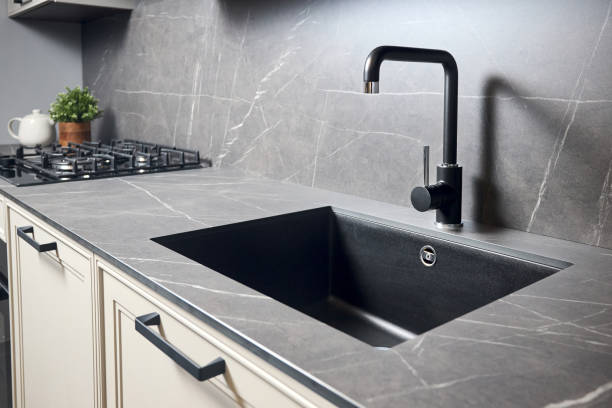A kitchen sink is more than just a functional fixture—it’s one of the most frequently used elements in any household. From washing vegetables and cleaning dishes to handling everyday cooking tasks, the sink plays a vital role in maintaining efficiency and hygiene in the kitchen. One key feature that homeowners often overlook when choosing a sink is easy drainage. A well-designed drainage system not only ensures water flows away quickly but also prevents buildup of food particles, bacteria, and unpleasant odors.
Selecting the best kitchen sink features for easy drainage can transform your cooking space into a cleaner, more practical, and more enjoyable environment. This article explores the most important features, materials, and design choices that contribute to optimal drainage performance, while also providing a comparison of different options available in the market.
Why Easy Drainage Matters in Kitchen Sinks
When water doesn’t drain properly, it can create a range of problems, from minor inconveniences to serious hygiene risks. Standing water leads to bacteria growth, food residue buildup, and even damage to the sink material over time. An effective drainage system ensures:
- Hygiene – Proper drainage prevents bacterial accumulation and odors.
- Durability – Less standing water means reduced risk of corrosion, rust, or staining.
- Convenience – Faster cleanup and smoother kitchen tasks.
- Aesthetic appeal – A well-draining sink looks cleaner and more modern.
Ultimately, easy drainage contributes to a more functional and long-lasting kitchen sink, making it one of the top priorities for homeowners and kitchen remodelers.
Key Kitchen Sink Features That Improve Drainage
1. Sloped Sink Base
The slope or gradient of the sink bottom is critical for directing water toward the drain. A well-engineered slope ensures there are no flat areas where water can stagnate. Ideally, the slope should be subtle enough to maintain stability for dishes but steep enough to allow efficient flow.
2. Position of the Drain
Central drains are common, but offset drains have gained popularity because they provide more usable space within the sink while still maintaining smooth water flow. An offset drain, especially when paired with a sloped base, prevents puddling and offers extra storage beneath the sink for plumbing and accessories.
3. Sink Material
Certain materials naturally enhance drainage efficiency.
- Stainless Steel: Smooth surfaces allow water to glide easily, minimizing residue.
- Granite Composite: Resistant to staining, though it may require a slightly deeper slope.
- Fireclay: Aesthetic and durable, but should be paired with a proper slope for best drainage.
4. Rounded Corners and Edges
Sharp corners tend to trap water and debris, while rounded edges encourage smooth water flow and make cleaning much easier.
5. Drainage Accessories
Adding smart accessories enhances overall sink performance:
- Drainage Grids: Elevate dishes, allowing water to flow directly to the drain.
- Strainers: Prevent clogs by catching food particles without blocking water flow.
- Over-the-Sink Racks: Encourage airflow and fast drying while preventing water pooling.
6. Depth and Size of the Sink
Deeper sinks may require stronger slope designs to avoid water stagnation. Double-bowl sinks should be designed with efficient independent drainage for each side to prevent cross-flow.
Comparison Table: Features for Easy Drainage
| Feature | Benefit | Ideal For | Cost Impact |
| Sloped Sink Base | Directs water quickly to the drain | All kitchens | Moderate |
| Central Drain Placement | Standard, reliable water flow | Traditional sinks | Budget-friendly |
| Offset Drain Placement | Extra under-sink space, better water direction | Modern kitchens, small kitchens | Slightly higher cost |
| Stainless Steel Material | Smooth surface, corrosion-resistant | Busy kitchens, easy maintenance | Affordable to premium |
| Granite Composite Material | Durable, stylish, requires deeper slope | Contemporary designs | Mid to high range |
| Rounded Corners | Easier cleaning, prevents water traps | Families, frequent cooks | Minimal extra cost |
| Drainage Grids & Strainers | Prevent clogging, enhance water flow | Any kitchen needing low-maintenance cleaning | Low additional cost |
Analyzing the Table
The comparison highlights how each feature contributes differently to drainage efficiency and convenience. For example, while central drains are cost-effective and standard, offset drains deliver better usability and improved storage space, making them ideal for modern kitchens. Stainless steel sinks remain a popular choice because of their smooth finish and affordability, though granite composite adds elegance with slightly more investment. Rounded corners and drainage accessories, though minor additions, significantly enhance daily cleaning and maintenance.
Ultimately, the best choice depends on balancing functionality, design preference, and budget. Homeowners looking for a long-term solution should prioritize sloped bases, offset drains, and stainless steel construction, while those focused on aesthetics may lean toward granite composite with rounded corners.
Practical Tips for Choosing the Right Kitchen Sink
- Assess Your Kitchen Layout – A smaller kitchen may benefit more from an offset drain to maximize under-sink storage.
- Consider Cleaning Habits – If you frequently cook or wash large utensils, opt for a sink with rounded corners and a deeper slope for effortless cleanup.
- Choose Quality Materials – Stainless steel offers practicality and longevity, while granite provides style and durability.
- Add Smart Accessories – Incorporate sink grids, strainers, and over-the-sink racks for extra functionality.
- Balance Budget and Needs – Sometimes a small investment in features like rounded corners or offset drains saves more in maintenance and convenience over time.
Frequently Asked Questions (FAQs)
Q1. Why does my kitchen sink drain slowly even though it has a slope?
A slow-draining sink may be caused by debris buildup in the pipes, clogged strainers, or poor-quality slope design. Regular cleaning and investing in proper accessories like strainers can resolve this issue.
Q2. Are offset drains better than central drains for easy drainage?
Yes, offset drains often improve drainage by allowing water to flow more directly, while also offering extra cabinet space below. However, they may come at a slightly higher cost compared to traditional central drains.
Q3. What sink material is best for preventing water stains and residue?
Stainless steel is highly recommended because of its smooth surface, which resists water spots and allows faster drainage. Granite composite is also effective but may need a stronger slope to achieve the same results.
Q4. Do rounded corners really make a difference?
Absolutely. Rounded corners prevent water and debris from getting trapped, making sinks easier to clean and ensuring smoother water flow toward the drain.
Q5. Should I invest in drainage accessories if I already have a sloped sink?
Yes. Even with a sloped base, accessories like grids and strainers help prevent clogs and keep dishes elevated, allowing water to drain more efficiently.
Conclusion
A well-designed kitchen sink is a blend of functionality, style, and hygiene. Among the many features to consider, easy drainage should be at the top of your list. From sloped bases and offset drains to smart accessories and durable materials, each detail enhances the way water flows and how clean your sink remains over time.
When selecting the best kitchen sink features for easy drainage, think about your kitchen’s layout, your daily habits, and your long-term needs. Small investments in design and accessories can save time, reduce maintenance, and make your kitchen a more efficient space.
Upgrade your kitchen with a sink that not only looks good but also works effortlessly—because a clean, well-drained sink is the foundation of a cleaner, healthier, and more enjoyable kitchen.

